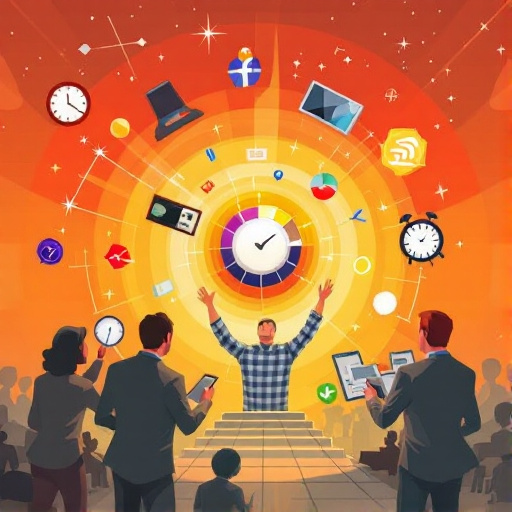Featured Articles
- 7 Game-Changing AI Recruitment Platforms Released Since 2019 That Are Redefining Hiring Efficiency
- Harnessing the Power of Micro-Experiences: A New Frontier in Employee Engagement and Retention Strategies
- Navigating the Quirks of Remote Teams: Unconventional HR Tips for Boosting Virtual Morale
- Top 6 Workforce Analytics Platforms Launched Since 2019: In-Depth Reviews and ROI Rankings for HR Leaders
- Top 8 Talent Management Tools Launched Since 2019: A Comprehensive Comparison and Buyer’s Guide
Navigating the Quirks of Remote Teams: Unconventional HR Tips for Boosting Virtual Morale
Navigating the Quirks of Remote Teams: Unconventional HR Tips for Boosting Virtual Morale
Remote work can feel like a double-edged sword—offering flexibility but challenging team spirit. This article unpacks unconventional HR tips and playful strategies to boost morale within virtual teams, ensuring that remote work remains engaging and productive.
Setting the Scene: The New Normal of Remote Work
In a world where remote work has jumped from a rarity to a commonality, the dynamics of team interaction have shifted dramatically. According to a report by Gartner, 88% of organizations globally mandated or encouraged employees to work from home, revealing the need for innovative approaches to maintain team morale (Gartner, 2020). In this context, HR professionals must redefine what it means to foster a motivated workforce—one that is separated physically yet interconnected digitally.
The Importance of Virtual Connection
To put things into perspective: A study by Buffer found that loneliness was the number one struggle for remote workers (Buffer, 2021). The lack of impromptu office chats and casual interactions can lead to feelings of isolation. Thus, promoting authentic connections through virtual platforms becomes crucial. If employees feel connected, they are 12% more productive, according to research by Gallup (Gallup, 2021).
Embrace the Quirks: Unique Team Rituals
Now, let’s talk rituals—no, not those creepy ones from horror movies! Think along the lines of virtual coffee breaks or quirky themed meetings. Why not have 'Wacky Sock Wednesdays' where team members flaunt their wildest socks during video calls? It's a simple yet effective way to inject fun into the workday and foster connections. A survey by O.C. Tanner revealed that 79% of employees who have fun at work report higher job satisfaction (O.C. Tanner, 2018). A bit of laughter goes a long way!
Story: The Lucky Sock Revolution
Consider the case of a marketing team at a tech startup that struggled with morale. They decided to host 'Wacky Sock Wednesdays.' Surprisingly, the concept took off! Employees started sharing photos of their socks on a dedicated Slack channel, which brightened everyone’s spirits. During one meeting, someone wore a full dinosaur costume along with their socks! The team bonded over their shared silliness, leading to an extraordinary increase in collaboration on projects.
Personalized Recognition Programs
Personalized recognition can make a significant difference in motivating remote employees. Traditional recognition programs may not resonate with everyone, so innovate! Consider creating a 'Kudos Corner', where employees can publicly recognize their peers for unique contributions or extraordinary efforts. Data suggests that 70% of American employees say they would work harder if their efforts were recognized (Achievers, 2021).
Fun with Quizzes and Polls
Integrating fun quizzes and polls can also be an adventurous way to engage employees. Use tools like Kahoot or Mentimeter to host quizzes focused on various topics—be it trivia, company history, or even quirky icebreakers. This improves team bonding while providing a refreshing break from standard work routines. Imagine the joy when a shy team member surprises everyone with their trivia prowess!
Statistics in Play
According to Gallup’s 2021 Employee Engagement survey, companies that cultivate employee engagement see 21% greater profitability. So, while humor and fun may feel trivial, they are, in fact, vital elements in maintaining a thriving remote environment.
Building a Culture of Open Communication
A culture of open communication is critical for remote teams. Gone are the days of casual water cooler chats; now, transparency and feedback must be curated intentionally. Schedule regular check-ins, not just for project updates, but also to gauge team sentiments. Aim for psychological safety, where all team members feel secure expressing their opinions or concerns without fear of backlash.
The Magic of Virtual Happy Hours
Virtual happy hours can also break the ice significantly. Instead of the usual work chatter, encourage conversations about hobbies, interests, or various Netflix shows everyone is currently binge-watching. This practice could lead to creative collaboration, as new ideas often sprout from such informal settings, cultivating a friendly atmosphere while reinforcing team bonds.
Learning Together: Professional Development Goals
Integrating professional development into the remote work routine can also uplift spirits. Conduct monthly sessions where team members can share knowledge or host lightning talks on their areas of expertise. According to a HBR study, 64% of employees see opportunities for growth and development as a major factor in job satisfaction. By learning together, you foster a sense of community that transcends the physical divide.
Case Study: The Power of Clarity
A mid-size software company implemented weekly “growth sessions” where employees could develop skills of their choice, ranging from coding languages to personal grooming tips. Not only did participation in these sessions increase overall satisfaction, but they also reported a 50% decrease in turnover rates. Employees felt appreciated, valued, and eager to contribute their skills back to the company.
The Fun of Gamification
Let’s get gamified! Incorporating gamification elements into the work process can make tasks feel less daunting and more engaging. Consider introducing a points system where employees earn points for task completion, collaboration, and participation in virtual events. At the end of the month, the top performers can win a quirky prize—think gift cards, or even something silly, like a llama plushie!
The Quirky Office Plant Challenge
To add a bit of color to the workday, consider an office plant challenge via video calls. Employees can showcase their plant babies, discuss plant care tips, and share photos of their little green friends. You can even have a contest for the “Most Impressive Plant” at the end of the quarter. Horticultural therapy is known for reducing stress and increasing productivity—win-win!
The Role of Leadership in Remote Morale
While HR holds a significant role in engaging remote teams, leadership sets the tone. Leaders should embody the company’s values. Regularly acknowledge and celebrate team achievements, no matter how small. You might even consider sending handwritten notes or quirky company swag to express appreciation. A personal touch can go a long way in reminding employees they are valued.
Implementing Fun Surveys
Surveying your team informally can help gauge morale and engagement levels. Craft fun, interactive surveys with a splash of humor. Queries might include “What animal would you be on a Zoom call?” or “What’s your survival strategy in a zombie apocalypse?” These light-hearted activities can provide insights into team dynamics while keeping the mood light.
Statistics to Ponder
According to a survey by Zippia, 70% of workers are not engaged at work. By employing some of the strategies above, you can combat disengagement—creating a vibrant, thriving remote work culture that encourages participation & commitment.
Conclusion: A Bit of Quirk Can Go a Long Way
As we navigate the quirky landscape of remote teams, implementing unconventional HR strategies can lead to enhanced virtual morale and improved productivity. Building camaraderie in a digital framework may take creativity and effort, but by integrating fun, communication, and innovation, HR professionals can keep the spirit of teamwork alive—even from a distance. So, throw on those wacky socks, grab a virtual drink with colleagues, and get ready to elevate the remote work experience!




